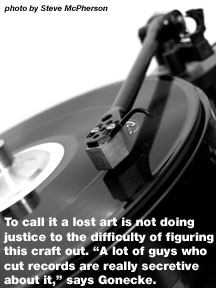Aaron Gonecke interviewed on his profession. What does he do? He cuts records. Interview, dubplatecutter.com
“When record cutting started out, when Edison had that machine, what it was, if you can imagine, was a speaker diaphragm, you know the speaker cone with a needle on the back, so when he’d scream into it, the cone would go up and down and that needle would hit that tinfoil and make this mark and then when he played it over, it would make the speaker move back just the same way as his voice made it move. So cutting started as up and down: vertical. What they found over time was, if they did it side to side they had less distortion. [Then] they tried to make stereo, so the first thing they [tried was] a turntable with one tone arm with two headshells and two needles and a record with two separate tracks and you’d have to get ‘em lined up perfect and start ‘em and one would be playing the right channel and one would be playing the left channel. And like nobody cared; it was a pain in the ass to use and it lasted like a year. So then they started saying, ‘How can we pack it into one groove?’ Well, we can go vertical and then horizontal. So up and down [for left] and then side to side [for right]. And what happened then was the right channel would sound really good and the left channel would be totally distorted. And what they ended up doing was taking the L shape and turning it into a V. And so what happened is each channel was vertical and horizontal at the same time. [But] the mechanical aspect is that higher treble is vertical and then lower treble becomes horizontal and then bass is totally horizontal. And that’s why you have limitations [like not being] able to have stereo effects in bass because you’ve got this winding little river right there and when it’s going side to side that’s making the bass and it can’t go to two sides at once.”




